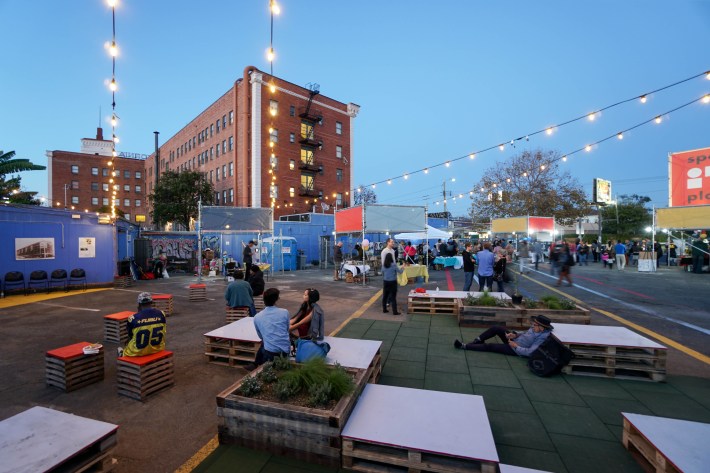"Why wait five or six years before doing anything with the space?" was the question Brad Leibin, an architect at David Baker Architects, was asked to help solve about an affordable housing project planned for West Oakland's San Pablo Avenue at 34th Street. "So we started to make a difference on that streets-cape immediately ... that project got me really interested in interim uses."
Leibin was part of a panel discussion earlier this week at SPUR's urban center in San Francisco. Throughout the Bay Area, projects get stuck in long planning processes and environmental reviews. Rather than leave project sites fallow, many architects and planning officials have found ways to enliven the spaces so they don't remain fallow while the bureaucracies churn.
One of the best known temporary activation of a site is "Proxy," built on two city-owned lots in Hayes Valley. Its story, explained Douglas Burnham of Envelope Architecture + Design, started in 1989. "The Loma Prieta earthquake damaged the freeway that used to cut Hayes Valley in two." The freeway was torn down and Octavia Boulevard replaced it. That created "23 vacant lots of unusual shapes and sizes, all slated for housing."
But housing is at the mercy of many things, including recessions. "The second disaster was the 2008 economic downturn, at which time most developments were put on hold, so we responded to a 'Request for Proposals' from the mayor’s office for any vacant lots," explained Burnham. "We saw the two lots adjacent to Patricia’s Green as having a potential for a unique interim use that involved commerce, culture and community."

They started this activation project with something universal: food and drink. "Food brings a place conviviality," said Burnham. So they brought in "Suppenkuche‘s 100-seat beer garden and Ritual Coffee." That was followed by collaborations with apparel stores and other services. "A couple of years ago we started collaborating with 'Basic Training' fitness." The idea, said Burnham, was to make it feel like a public space where things are happening organically, but "we are essentially curating all the things."
Of course, since it is an interim use, the architects had to come up with quick, mobile, temporary structures. In this case, it meant cargo containers. "We encouraged micro enterprise and very small footprint buildings."

While Proxy is probably the best known interim-use project, there are many others in progress in the Bay Area, on Market between 12th and Brady, in Bayview-Hunters Point, and in West Oakland, to name a few.
Annie Ledbury of the East Bay Asian Local Development Corporation talked about work to revitalize the San Pablo Avenue corridor in West Oakland. "There’s been structural disinvestment over time, but it’s got great bones and great history." Realizing they can't rebuild the entire area, they started to look for small affordable investments in "hot spots for blight" with an eye on building "social cohesion."

Meanwhile, next to the California Hotel, there was a parking lot with a "1,500 square foot liquor store. We had this idea of putting in mixed use housing." That's underway and will break ground in a few years. But what to do in the interim? "We jumped in and did projects for $300 to $1,000 each." They started by putting up a giant sign that read: "what do you want to see here" and solicited, for lack of a better phrase, productive graffiti in the form of suggestions scribbled on the sign by locals.
"It's a neighborhood that really lacks open space. So we wanted to brighten it up with color and landscaping and activity," said Leibin (his firm is designing the housing that will eventually go on this San Pablo site). They brought in vendor stalls, arts, etc. "The idea that I thought was really cool was to bring arts and cultural performances to activate the space and incubate local businesses."

Some of the design elements, so painstakingly developed with community input, will become part of the permanent structure.
All of this is part of a planning philosophy that puts community and human interaction at the center of design, explained the San Francisco Planning Department's Neil Hrushowy. Traditionally, different city departments work from bureaucratic silos and build things without thinking of the overall social impact. SFMTA might build a transit line, and planning might approve a housing complex, but what about the overall social cohesion and sense of neighborhood? "Sometimes we run the city as if the purpose of the city government is only to run transit, clean streets, run schools--these are all laudable goals but they miss a bigger picture," said Hrushowy. Modern planners, he added, need to think of the impact of all projects on the greater social fabric. "Social conditions, social connections and feeling related are central to the ability to thrive and lead a life of happiness and well-being."
Which certainly dictates that vacant lots, slated for projects, should be made lively until the bulldozers are actually turning dirt.
So what happens to those temporary activations when the dozers finally show up? If designed properly, they get picked up, put on trucks, and plunked down on the next vacant lot waiting for a project. "The shipping containers have just four bolt points. They come apart," explained Burnham.

For more events like these, visit SPUR’s events page.






